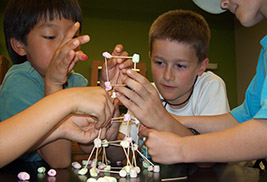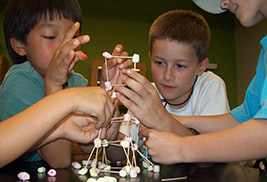Featured Article
Learning Science Outside of the Classroom
While most can agree that STEM (science, technology, engineering and mathematics) experiences outside of school can be exciting and engaging for young people, there is much that isn’t known about its impact on short- and long-term learning.
read moreLearning Science Outside of the Classroom
Posted Feb. 16, 2015 | Jim MaxwellKent State’s SOLE Center researchers to study informal STEM learning experiences with NSF grant

Great Lakes Science Center in Cleveland serves more
than 2,000 students each summer through its camp
programs that help combat the summer learning loss,
provide an engaging setting for out-of-school-time learning
and allow kids to explore Science, Technology, Engineering
and Mathematics (STEM) through hands-on experiments
that mimic real-world challenges. The science center is
partnering with Kent State University, University of Limerick,
ideastream and The Irish Independent newspaper on a
National Science Foundation (NSF) project.
(Photo credit: Great Lakes Science Center)
While most can agree that STEM (science, technology, engineering and mathematics) experiences outside of school can be exciting and engaging for young people, there is much that isn’t known about its impact on short- and long-term learning. How can it best be connected to what students are learning in school? How can young people have equitable opportunities to access quality informal science education? How do you measure this kind of learning?
The National Science Foundation (NSF) wants to address these questions and has recently awarded Kent State University, and its collaborative partners, a $115,000 grant to develop a prototype assessment tool to map informal STEM learning experiences. Led by Principal Investigator Bradley Morris, associate professor in the School of Lifespan Development and Educational Sciences at Kent State, the university will partner with the Great Lakes Science Center, University of Limerick, ideastream and The Irish Independent newspaper on the project.
The first phase planning grant will allow the researchers to develop research questions and designs for a Phase 2 “Science Learning+” proposal to the NSF.
The long-term goals of the program are to broaden participation in STEM and to better understand, strengthen and coordinate STEM engagement and lifelong learning. An NSF press release stated, “In the second phase, NSF and Wellcome Trust intend to fund several significant, longer-term research projects of approximately $2.4 million each for up to five years (possibly more for long-term longitudinal studies).”
“Children’s interest in science can be sparked by many things like a trip to a science center, watching a science program on TV or reading an article in a newspaper,” Morris says. “Unfortunately, there hasn’t been much research measuring the impact of these experiences on science learning. Our goal is to measure where science learning occurs and how these different experiences outside of school influence children’s interest in and knowledge of science.”
Initially, the researchers plan to develop an assessment tool, based on a mobile technology platform, to study the effectiveness of informal learning during and after class field trips to the Great Lakes Science Center in Cleveland. The tool will focus on the impact of the learning ecologies on knowledge, interest, identity and reasoning rather than emphasize learning in a specific content area. It also will assess the goals that people set as they engage in STEM learning within each ecology and will measure the individuals’ duration and level of engagement.
“This is the first of many grants we hope to receive that will support our recently established multidisciplinary initiative called the Science of Learning and Education Center, or SOLE Center, at Kent State,” says SOLE Center Director John Dunlosky, a professor of psychology at Kent State. “Ultimately, we want to foster evidence-based reform of STEM education, health education and literacy, and language learning to improve achievement for K-12 students in the surrounding community.”
The SOLE Center, led by Dunlosky, includes Morris as associate director and 15 other faculty members from the College of Arts and Sciences and the College of Education, Health and Human Services at Kent State.
According to the NSF’s website, the Science Learning+ program will provide up to $14.4 million to support research into how learning happens outside the classroom, exploring the most effective practices and building the evidence base in this area. The aims are to learn more about, evaluate and maximize the impact of informal learning experiences, and to improve understanding of how informal environments may help to widen access to STEM for youth from all backgrounds.
“These projects will help us to learn more about the impact of informal STEM learning experiences,” says NSF Program Director Dennis Schatz. “They’ll also improve our understanding of how informal environments may help to widen access to STEM for young people from all backgrounds.”
For more information about Kent State’s SOLE Center, visit www.kent.edu/sole.
